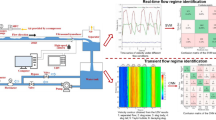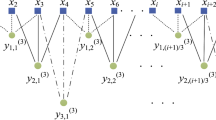Abstract
In this experimental study a new flow regime map for gas–liquid two-phase flow regime detection is presented based on interpretation of transient flow pressure signals and utilizing neural networks. In this regard, the pressure signals of an air–water two phase flow at different location on a vertical pipe with an inside diameter of 50 mm and a total length of 6 m are measured. Averaged pressure and pressure fluctuation data were analyzed in different flow regimes along the upriser pipe to recognize the effects of flow regimes on pressure response. A set of pressure parameters are introduced based on averaged pressure data to present meaningful criteria for flow regime identification. Pressure fluctuations also used for flow regime recognition by applying two common signal processing methods. The processed signals are used as the inputs of a feed forward back propagation neural network to predict the flow regime. The neural network outputs are then used to present a flow regime map. The proposed neural network flow map is compared with the experimental data by photographic flow visualization technique. This comparison shows an acceptable agreement between the neural network outputs and experimental results.










Similar content being viewed by others
References
Bin S, Hong W (2010) Identification method of gas–liquid two phase flow regime based on distance evaluation. In: Proceedings of the 6th international conference on natural computation (ICNC), IEEE, pp 1266–1270
Chen L, Tian YS, Karayiannis TG (2006) The Effect of tube diameter on vertical two-phase flow regimes in small tubes. Int J Heat Mass Transf 49:4220–4230
Elperin T, Klochko M (2002) Flow regime identification in a two phase flow using wavelet transform. Exp Fluids 32(6):674–682
Ghanbarzadeh S, Hanafizadeh P, Saidi MH, Boozarjomehry RB (2010) Intelligent regime recognition in upward vertical gas–liquid two phase flow using neural network techniques. In: Proceedings of the 3rd joint US-European fluid engineering summer meeting and 8th international conference on nanochannels, michrochannels and minichannels (FEDSM-ICNMM), Montreal, Canada
Ghanbarzadeh S, Hanafizadeh P, Saidi MH (2012) Intelligent imaged-based gas–liquid two-phase flow regime recognition. ASME J Fluids Eng 134(6):061302
Hanafizadeh P, Ghanbarzadeh S, Saidi MH (2011) Visual technique for detection of gas–liquid two-phase flow regime in the airlift pump. J Petrol Sci Eng 75:327–335
Hernandez L, Julia JE, Ozar B, Hibiki T, Ishii M (2011) Flow regime identification in boiling two phase flow in a vertical annulus. ASME J Fluids Eng 133(9):091304
Hewitt GF, Roberts DN (1969) Studies of two phase flow patterns by simultaneous X-ray and flash photography. Defence Technical Information Center, Harwell
Hu HL, Dong J, Zhang J, Cheng YJ, Xu TM (2011) Identification of gas/solid two phase flow regimes using electrostatic sensors and neural network techniques. Flow Meas Instrum 22(5):482–487
Hua C, Wang C, Geng Y, Shi T (2010) Noninvasive flow regime identification for wet gas flow based on flow-induced vibration. Chin J Chem Eng 18(5):795–803
Jana AK, Das G, Das PK (2006) Flow regime identification of two phase liquid–liquid up flow through vertical pipe. Chem Eng Sci 61(5):1500–1515
Jonesjr O, Zuber N (1975) The interrelation between void fraction fluctuations and flow patterns in two-phase flow. Int J Multiph Flow 2(3):273–306
Kreitzer PJ, Hanchak M, Byrd L (2013) Flow regime identification of horizontal two phase refrigerant R-134a flow using neural networks. In: Proceedings of the ASME 2013 international mechanical engineering congress and exposition, San Diego, California, USA, 7B, V07BT08A059
Kreitzer PJ, Hanchak M, Byrd L (2012) Horizontal two phase flow regime identification: comparison of pressure signature, electrical capacitance tomography (ECT) and high speed visualization. In: Proceedings of the ASME 2012 international mechanical engineering congress and exposition, Houston, Texas, USA, vol 7, pp 1281–1291
Lee JY, Ishii M, Kim NS (2008) Instantaneous and objective flow regime identification method for the vertical upward and downward co-current two phase flow. Int J Heat Mass Transf 51(13–14):3442–3459
Lowe D, Rezkallah KS (1999) Flow regime identification in microgravity two-phase flows using void fraction signals. Int J Multiph Flow 25(3):433–457
Matsui G (1986) Automatic identification of flow regimes in vertical two phase flow using differential pressure fluctuations. Nucl Eng Des 95:221–231
Mi Y, Ishii M, Tsoukalas LH (1998) Vertical two phase flow identification using advanced instrumentation and neural networks. Nucl Eng Des 184(2–3):409–420
Paranjape S, Chen SW, Hibiki T, Ishii M (2011) Flow regime identification under adiabatic upward two-phase flow in a vertical rod bundle geometry. ASME J Fluids Eng 133(9):091302
Roy M, Kumar VR, Kulkarni BD, Sanderson J, Rhodes M, van der Stappen M (1999) Simple denoising algorithm using wavelet transform. AIChE J 45:2461–2466
Shaban H, Tavoularis S (2014) Identification of flow regime in vertical upward air–water pipe flow using differential pressure signals and elastic maps. Int J Multiph Flow 61:62–72
Sun B, Zhang H, Cheng L, Zhao Y (2006) Flow regime identification of gas–liquid two phase flow based on HHT. Chin J Chem Eng 14(1):24–30
Tutu NK (1982) Pressure fluctuations and flow pattern recognition in vertical two phase gas–liquid flows. Int J Multiph Flow 8(4):443–447
Venkatesan M, Das SK, Balakrishnan AR (2011) Effect of diameter on two-phase pressure drop in narrow tubes. Exp Therm Fluid Sci 35:531–541
Wu H, Zhou F, Wu Y (2001) Intelligent identification system of flow regime of oil–gas–water multiphase flow. Int J Multiph Flow 27(3):459–475
Xu LJ, Xu LA (1998) Gas/liquid two phase flow regime identification by ultrasonic tomography. Flow Meas Instrum 8(3–4):145–155
Yingzhen Y, Guangjun L, Fangde Z, Xuejun C (2001) The effect of sudden change in pipe diameter on flow patterns of air-water tow-phase flow in vertical pipe (I) Sudden-contraction cross-section. Chin J Chem Eng 9(1):116–119
Zhao TS, Bi QC (2001) Co-current air–water two phase flow patterns in vertical triangular micro channels. Int J Multiph Flow 27(5):765–782
Author information
Authors and Affiliations
Corresponding author
Rights and permissions
About this article
Cite this article
Hanafizadeh, P., Eshraghi, J., Taklifi, A. et al. Experimental identification of flow regimes in gas–liquid two phase flow in a vertical pipe. Meccanica 51, 1771–1782 (2016). https://doi.org/10.1007/s11012-015-0344-4
Received:
Accepted:
Published:
Issue Date:
DOI: https://doi.org/10.1007/s11012-015-0344-4




